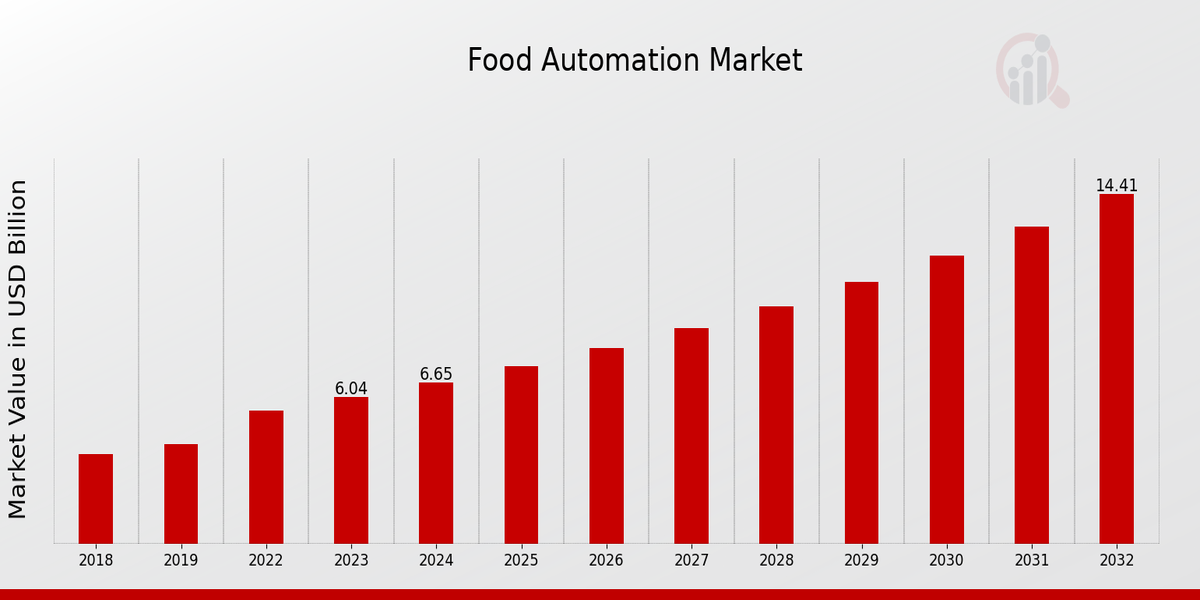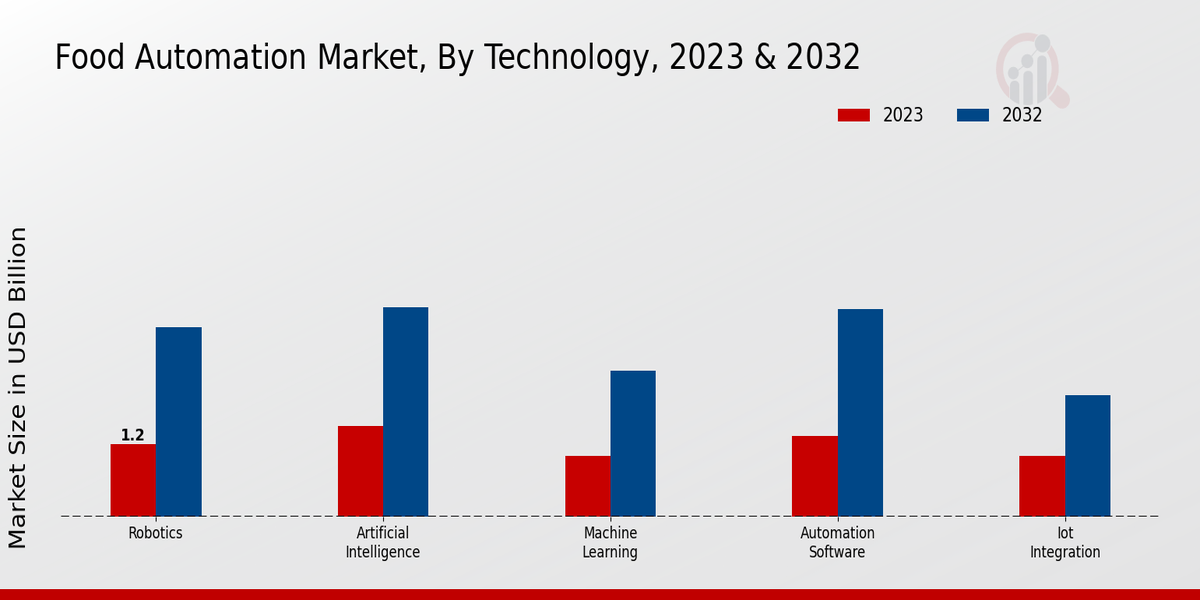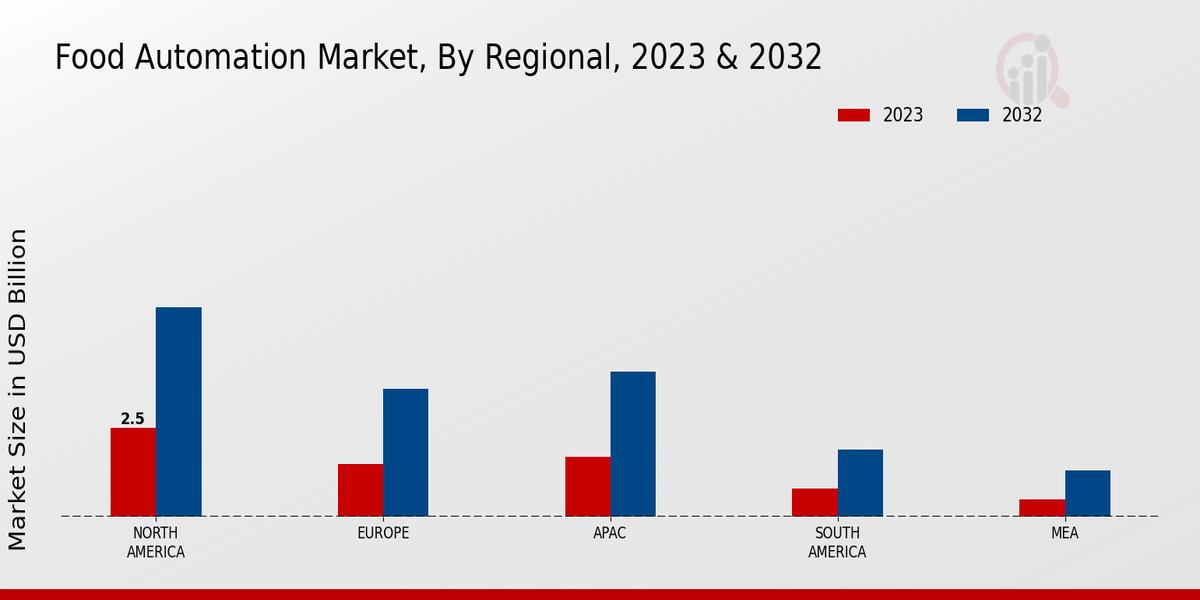Global Food Automation Market Overview
Food Automation Market Size was estimated at 5.48 (USD Billion) in 2022. The Food Automation Industry is expected to grow from 6.04(USD Billion) in 2023 to 14.4 (USD Billion) by 2032. The Food Automation Market CAGR (growth rate) is expected to be around 10.15% during the forecast period (2024 - 2032).

Source Primary Research, Secondary Research, MRFR Database and Analyst Review
Key Food Automation Market Trends Highlighted
The Food Automation Market is experiencing significant growth driven by various factors. The increasing demand for processed and packaged food, coupled with a shift towards automation in food production, is pushing companies to invest in advanced technologies. Labor shortages and the need for improved efficiency are also major contributors, as automation helps to streamline operations and reduce costs. The push for enhanced food safety and quality assurance is prompting companies to adopt automated solutions that minimize human error. Additionally, governments and organizations are increasingly focusing on sustainability, encouraging food manufacturers to adopt more efficient processes.
There are numerous opportunities in the Food Automation Market that can be explored. Innovations in artificial intelligence and machine learning offer potential enhancements in production efficiency and quality control. Furthermore, the integration of IoT (Internet of Things) in food processing presents opportunities for real-time monitoring and data analytics, allowing companies to optimize their operations. Emerging markets are also on the rise, presenting new avenues for companies looking to expand their automated food processing capabilities. Collaborative robots and advanced sensory technology can further enhance flexibility and responsiveness in food production.In recent times, trends such as the increasing adoption of robotics and automated storage solutions are gaining momentum. Companies are moving towards smart factories that leverage automation to create more responsive and agile supply chains. The focus on personalization in food production is also driving technological advancements that allow for more tailored product offerings. Sustainability remains a significant trend, with an emphasis on energy-efficient and waste-reductive technologies becoming more prevalent. As consumer preferences shift and technology continues to evolve, the Food Automation Market is likely to adapt, revealing new trends and opportunities for growth.
Food Automation Market Drivers
Increasing Demand for Food Safety and Quality
The Food Automation Market Industry is experiencing a significant rise in the demand for food safety and quality assurance. As consumers become more health-conscious and aware of foodborne diseases, companies are under pressure to enhance the quality and safety measures in their production processes. Automation technologies such as advanced manufacturing systems, robotics, and quality control machines play a crucial role in ensuring that food products meet regulatory standards and consumer expectations.These technologies not only help in maintaining consistent quality but also minimize human error, which can lead to contamination or subpar products. The focus on traceability and transparency in food production further drives companies to adopt automation solutions that can monitor processes in real time and provide reliable data. As a result, the investment in automated systems is becoming a strategic priority for businesses looking to improve their operational efficiency while adhering to stringent safety standards.The growing awareness among consumers about ingredient sourcing and production methods is also propelling the demand for automated processes that can deliver higher levels of food safety. With the population projected to grow, the need for safer, quality food products will inevitably lead to an increase in the adoption of automation technologies across the food industry.
Advancements in Technology and Innovation
Technological advancements are a key driver of growth in the Food Automation Market Industry. The introduction of innovative solutions such as the Internet of Things (IoT), artificial intelligence (AI), and machine learning is transforming how food is processed and produced. These technologies enable real-time monitoring of production lines, predictive maintenance of machinery, and enhanced decision-making capabilities. By optimizing production processes, companies can achieve higher efficiency and reduce operational costs.Automation solutions are designed to improve productivity, ensuring that businesses can meet the increasing demand for food without compromising on quality. This trend is particularly evident in the rise of smart factories that leverage data analytics to streamline operations and enhance productivity.
Need for Increased Production Efficiency
In the Food Automation Market Industry, there is a pressing need for increased production efficiency. As food demand continues to escalate due to rising populations and changing dietary preferences, manufacturers are challenged to maximize output while minimizing costs. Automation plays a crucial role in addressing these challenges, providing tools that help streamline processes, reduce waste, and ensure a faster turnaround time in production.Automated systems allow for better resource allocation, precise ingredient measurements, and consistent product quality, enabling companies to scale their operations effectively. This focus on efficiency not only helps in meeting market demands but also enhances profitability, making automation an attractive investment for businesses in the food sector.
Food Automation Market Segment Insights
Food Automation Market Technology Insights
The Food Automation Market within the Technology segment has showcased significant growth and potential, being valued at 6.04 USD Billion in 2023 and projected to reach 14.4 USD Billion by 2032. This notable progression is driven by advancements across multiple facets of technology, with Robotics, Artificial Intelligence, Machine Learning, Automation Software, and IoT Integration playing crucial roles. Robotics, with a valuation of 1.2 USD Billion in 2023 and expected to rise to 3.12 USD Billion by 2032, exhibits a majority holding in streamlining processes, particularly in packaging and material handling, which has proven essential in enhancing operational efficiency in food production.
Artificial Intelligence, contributing a value of 1.5 USD Billion in 2023 and predicted to grow to 3.45 USD Billion, significantly aids in analytics and decision-making processes that optimize supply chains and inventory management for food manufacturers. Machine Learning's current valuation of 1.0 USD Billion in 2023, advancing to 2.4 USD Billion by 2032, further emphasizes its importance in predicting consumer preferences and improving product quality through data analysis. Automation Software, valued at 1.34 USD Billion in 2023, is also anticipated to see substantial growth, reaching 3.42 USD Billion as it lays the groundwork for integrated systems across various food automation processes, allowing for seamless operations and reduced labor costs.IoT Integration, currently valued at 1.0 USD Billion, is projected to increase to 2.01 USD Billion, underpinning the importance of connectivity in real-time monitoring and control of food production lines, which enhances traceability and compliance with safety regulations. Together, these segments highlight the evolving landscape of the Food Automation Market, driven by technological innovations aimed at improving productivity while ensuring quality and safety standards in food production. The growing need for efficiency, reduced operational costs, and enhanced accuracy are key growth drivers fueling the Food Automation Market, presenting unique opportunities for stakeholders to leverage these technologies to meet increasing consumer demands and address industry challenges.
While the market is poised for growth, it is essential to recognize potential challenges, such as the need for skilled labor to implement and maintain these advanced technologies and the cybersecurity risks associated with IoT integration. Overall, the various components of the Food Automation Market exhibit interdependencies that will shape future trends and developments, making this an exciting and dynamic sector to watch for advancements and innovations.

Source Primary Research, Secondary Research, MRFR Database and Analyst Review
Food Automation Market Application Insights
The Food Automation Market, valued at 6.04 billion USD in 2023, showcases a dynamic Application segment that encompasses essential areas such as Food Processing, Packaging, Food Safety and Quality Control, Inventory Management, and Logistics. This segment is critical as it drives efficiencies and enhances productivity across the food industry. Among these areas, Food Processing stands out for its significant automation potential, helping to streamline production principles and meet rising consumer demand for processed foods. Packaging automation continues to exhibit strong growth, focusing on enhancing product safety and improving shelf-life, which is paramount in today's fast-paced market.Food Safety and Quality Control automation is also crucial, ensuring compliance with regulatory standards and minimizing contamination risks. Furthermore, Inventory Management and Logistics optimize supply chain operations, reducing waste and ensuring timely delivery of food products. The overall Food Automation Market data reveals that these aspects collectively cater to evolving consumer preferences and operational requirements, positioning the market for sustained growth as it adapts to technological advancements and rising demand for automation solutions.
Food Automation Market End Use Insights
The Food Automation Market, projected to be valued at 6.04 USD Billion in 2023, shows significant growth potential, particularly within the End Use segment, which includes various categories such as Beverages, Meat Poultry, Dairy Products, Bakery, and Fruits Vegetables. This market segmentation highlights the rapid adoption of automation technology in processing and packaging food, driving efficiency and consistency across diverse product lines. The Beverages segment remains a crucial area where automation helps maintain quality control and enhances production speed, while the Meat Poultry segment benefits from automation in processing to ensure food safety and traceability.Dairy Products also utilize automation for packaging and quality assurance, catering to growing consumer demands for freshness. Furthermore, Bakery automation focuses on improving production efficiency, ensuring consistent quality while allowing for customization in baked goods. The Fruits Vegetables sector increasingly relies on automation for sorting and packaging, which helps reduce waste and streamline operations. Overall, the integration of automation in these segments contributes to the observed market growth by enhancing productivity, ensuring food safety, and meeting evolving consumer preferences, thereby reinforcing the relevance of the Food Automation Market statistics in revealing industry trends.
Food Automation Market Automation Type Insights
In 2023, the Food Automation Market was valued at 6.04 billion USD, with various Automation Types contributing to its growth. Among these, Fixed Automation plays a crucial role due to its high efficiency and suitability for mass production processes, catering to industries that require repetitive tasks. Programmable Automation offers flexibility in production runs, allowing manufacturers to adjust operations based on demand fluctuations, thus addressing the need for customized product offerings. Meanwhile, Flexible Automation is gaining significant traction as it enables manufacturers to quickly adapt their production lines in response to market changes, making it indispensable for companies seeking competitiveness and responsiveness.The diversification within Automation Types illustrates the dynamic nature of the Food Automation Market, which thrives on the necessity for enhanced efficiency, technology integration, and the pursuit of cost reduction across the food industry. As these automation solutions evolve, they are increasingly seen as essential components in optimizing production processes, contributing to the overall market growth and exemplifying the importance of these automation strategies in the food sector.
Food Automation Market Regional Insights
The Food Automation Market demonstrates a robust regional landscape, valued at 6.04 USD Billion in 2023 and projected to grow significantly in the coming years. North America leads this regional segmentation, holding a substantial 2.5 USD Billion, which is anticipated to increase to 5.9 USD Billion by 2032, reflecting its dominant position driven by technological advancements and high demand for automation in food processing. Europe follows closely with a 2023 valuation of 1.5 USD Billion, expected to reach 3.6 USD Billion, aided by increasing automation investments in the food industry.The APAC region, valued at 1.7 USD Billion currently, demonstrates strong growth potential with a projected value of 4.1 USD Billion, largely influenced by rapid industrial growth and urbanization. Meanwhile, South America and MEA are valued at 0.8 USD Billion and 0.5 USD Billion respectively in 2023, with expectations of reaching 1.9 USD Billion and 1.3 USD Billion, showing early development stages but highlighting growing interest in food automation technologies. This data illustrates the diverse opportunities across regions, showcasing varying degrees of growth and investment in the Food Automation Market, which is driven by increasing efficiency demands and the need for enhanced food safety standards.

Source Primary Research, Secondary Research, MRFR Database and Analyst Review
Food Automation Market Key Players and Competitive Insights
The competitive landscape of the Food Automation Market is characterized by rapid technological advancements and a constant push towards improving efficiency and productivity in food processing and distribution. As food manufacturers face increasing demand for higher quality and safer products, they are turning to automation to streamline operations, reduce labor costs, and ensure consistent output. Multiple players in the market are focusing on innovative solutions that harness artificial intelligence, machine learning, and robotics, enabling businesses to adapt to the ever-evolving consumer preferences and regulatory requirements. This environment fosters competition as companies strive to differentiate themselves through product offerings, service capabilities, and strategic partnerships.
In the context of the Food Automation Market, Food Automation Solutions stands out with its robust range of offerings designed to optimize food production and processing. With an emphasis on automation technology, the company has built a strong market presence thanks to its commitment to quality and efficiency. Their solutions incorporate advanced robotics, real-time data analytics, and machine vision systems that empower food manufacturers to enhance operational workflows. The company's strengths lie in its ability to not only provide state-of-the-art machinery but also to deliver tailored solutions that resonate with specific market needs. Food Automation Solutions is known for its customer-centric approach, which has solidified its reputation and contributed to increasing market penetration across various segments of the food industry.Wirths Solutions is another key player within the Food Automation Market, recognized for its innovative approaches to automating food production processes.
The company specializes in offering comprehensive solutions that cover various aspects of food handling, processing, and packaging. Wirths Solutions has established a strong foothold due to its focus on creating adaptable systems that meet the dynamics of food safety and production efficiency. Its technology integrates seamlessly with existing operations, allowing food manufacturers to scale their automation efforts without significant disruption. Wirths Solutions emphasizes continuous improvement and customer support, which are vital for clients looking to enhance their operational capabilities and remain competitive in a challenging market. Through strategic collaborations and a keen understanding of industry trends, Wirths Solutions positions itself effectively to leverage future opportunities in the rapidly evolving food automation landscape.
Key Companies in the Food Automation Market Include
- Food Automation Solutions
- Wirths Solutions
- Honeywell
- Mitsubishi Electric
- Yaskawa Electric
- Nordson
- ABB
- N2S Technologies
- Siemens
- Rockwell Automation
- Omron
- KUKA
- Adept Technology
- Fanuc
Food Automation Market Industry Developments
Recent developments in the Food Automation Market indicate a strong focus on enhancing productivity and efficiency through advanced automation technologies. Companies like Honeywell and Siemens are increasingly integrating AI and IoT solutions into their automation systems, driving innovation in food processing and packaging. The demand for automation solutions has surged due to labor shortages and the growing need for food safety, prompting firms like ABB and Mitsubishi Electric to expand their product offerings to meet market needs. Notably, Yaskawa Electric and Rockwell Automation are collaborating on joint projects to develop more sophisticated robotic systems tailored for food applications. In merger and acquisition activity, Nordson recently acquired a smaller automation technology firm to enhance its capabilities in the food sector. Additionally, market valuation trends suggest that companies such as Omron and KUKA are experiencing substantial growth due to increased investments in automation solutions, positively impacting the overall market landscape. These developments indicate a strategic shift towards more automated and efficient food production systems as companies aim to meet the evolving challenges and demands of the industry.
Food Automation Market Segmentation Insights
-
Food Automation Market Technology Outlook
- Robotics
- Artificial Intelligence
- Machine Learning
- Automation Software
- IoT Integration
-
Food Automation Market Application Outlook
- Food Processing
- Packaging
- Food Safety and Quality Control
- Inventory Management
- Logistics
-
Food Automation Market End Use Outlook
- Beverages
- Meat Poultry
- Dairy Products
- Bakery
- Fruits Vegetables
-
Food Automation Market Automation Type Outlook
- Fixed Automation
- Programmable Automation
- Flexible Automation
-
Food Automation Market Regional Outlook
-
North America
-
Europe
-
South America
-
Asia Pacific
-
Middle East and Africa
| Report Attribute/Metric |
Details |
| Market Size 2022 |
5.48(USD Billion) |
| Market Size 2023 |
6.04(USD Billion) |
| Market Size 2032 |
14.4(USD Billion) |
| Compound Annual Growth Rate (CAGR) |
10.15% (2024 - 2032) |
| Report Coverage |
Revenue Forecast, Competitive Landscape, Growth Factors, and Trends |
| Base Year |
2023 |
| Market Forecast Period |
2024 - 2032 |
| Historical Data |
2019 - 2023 |
| Market Forecast Units |
USD Billion |
| Key Companies Profiled |
Food Automation Solutions, Wirths Solutions, Honeywell, Mitsubishi Electric, Yaskawa Electric, Nordson, ABB, N2S Technologies, Siemens, Rockwell Automation, Omron, KUKA, Adept Technology, Fanuc |
| Segments Covered |
Technology, Application, End Use, Automation Type, Regional |
| Key Market Opportunities |
Increased demand for robotics, Expansion of smart kitchens, Growth in food delivery automation, Rising adoption of AI technologies, Enhanced food safety regulations |
| Key Market Dynamics |
Increasing labor costs, Growing demand for efficiency, Technological advancements, Rising food safety regulations, Shift towards automation solutions |
| Countries Covered |
North America, Europe, APAC, South America, MEA |
Frequently Asked Questions (FAQ) :
The Food Automation Market is expected to be valued at 14.4 USD Billion by 2032.
The market is anticipated to grow at a CAGR of 10.15% from 2024 to 2032.
North America is projected to hold the largest market share, valued at 5.9 USD Billion in 2032.
The market size for Robotics is expected to reach 3.12 USD Billion by 2032.
Major players such as Honeywell, Siemens, and ABB are expected to have substantial impacts on the market.
Machine Learning is anticipated to reach a market size of 2.4 USD Billion by 2032.
The market in Europe is projected to be valued at 3.6 USD Billion by 2032.
IoT Integration is expected to reach a market value of 2.01 USD Billion by 2032.
The outlook for the market during this period is positive, with consistent growth expected across all segments.
The market size for South America is anticipated to reach 1.9 USD Billion by 2032.

















